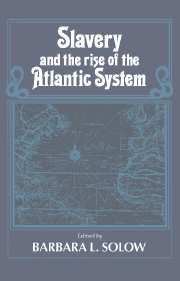Book contents
- Frontmatter
- Contents
- Preface
- List of contributors
- Introduction
- 1 Slavery and colonization
- 2 The Old World background of slavery in the Americas
- 3 Slavery and lagging capitalism in the Spanish and Portuguese American empires, 1492–1713
- 4 The Dutch and the making of the second Atlantic system
- 5 Precolonial western Africa and the Atlantic economy
- 6 A marginal institution on the margin of the Atlantic system: The Portuguese southern Atlantic slave trade in the eighteenth century
- 7 The apprenticeship of colonization
- 8 Exports and the growth of the British economy from the Glorious Revolution to the Peace of Amiens
- 9 The slave and colonial trade in France just before the Revolution
- 10 Slavery, trade, and economic growth in eighteenth-century New England
- 11 Economic aspects of the growth of slavery in the seventeenth-century Chesapeake
- 12 Credit in the slave trade and plantation economies
- Index
8 - Exports and the growth of the British economy from the Glorious Revolution to the Peace of Amiens
Published online by Cambridge University Press: 20 October 2009
- Frontmatter
- Contents
- Preface
- List of contributors
- Introduction
- 1 Slavery and colonization
- 2 The Old World background of slavery in the Americas
- 3 Slavery and lagging capitalism in the Spanish and Portuguese American empires, 1492–1713
- 4 The Dutch and the making of the second Atlantic system
- 5 Precolonial western Africa and the Atlantic economy
- 6 A marginal institution on the margin of the Atlantic system: The Portuguese southern Atlantic slave trade in the eighteenth century
- 7 The apprenticeship of colonization
- 8 Exports and the growth of the British economy from the Glorious Revolution to the Peace of Amiens
- 9 The slave and colonial trade in France just before the Revolution
- 10 Slavery, trade, and economic growth in eighteenth-century New England
- 11 Economic aspects of the growth of slavery in the seventeenth-century Chesapeake
- 12 Credit in the slave trade and plantation economies
- Index
Summary
I think I need not tell them that they live by TRADE: That their Commerce has rais'd them from what they were, to what they are; and may, if cultivated and improv'd, raise them yet farther to what they never were;…
It is obvious that the present strength and pre-eminence of this country is owing to the extent of its resources arising from its commerce and its naval power which are inseparably connected.
VERY-long-term trends in the growth and structure of English foreign trade cannot be quantified with any precision. Nevertheless, developments over the centuries before the Industrial Revolution are fairly clear. First, there occurred a protracted but unmistakable shift in the composition of English exports away from primary produce (principally raw wool, but including hides, skins, tin, and lead) toward a concentration on woollen textiles. That shift had already proceeded a long way by the mid-fifteenth century, when about two-thirds of the value of English exports took the form of woollen cloth. Sales of woollens outside the realm multiplied by a factor of three over the following century and by the opening years of Elizabeth's reign accounted for 80% of the nation's total exports (which amounted, at that time, to roughly £750,000).
Elizabeth's tiny kingdom enjoyed a comparative advantage in the manufacture of woollen cloth, which was exported undyed and unfinished, principally in the form of the internationally renowned broadcloth, but supplemented increasingly by cheaper and lighter fabrics such as “kerseys.”
- Type
- Chapter
- Information
- Slavery and the Rise of the Atlantic System , pp. 177 - 209Publisher: Cambridge University PressPrint publication year: 1991
- 34
- Cited by



